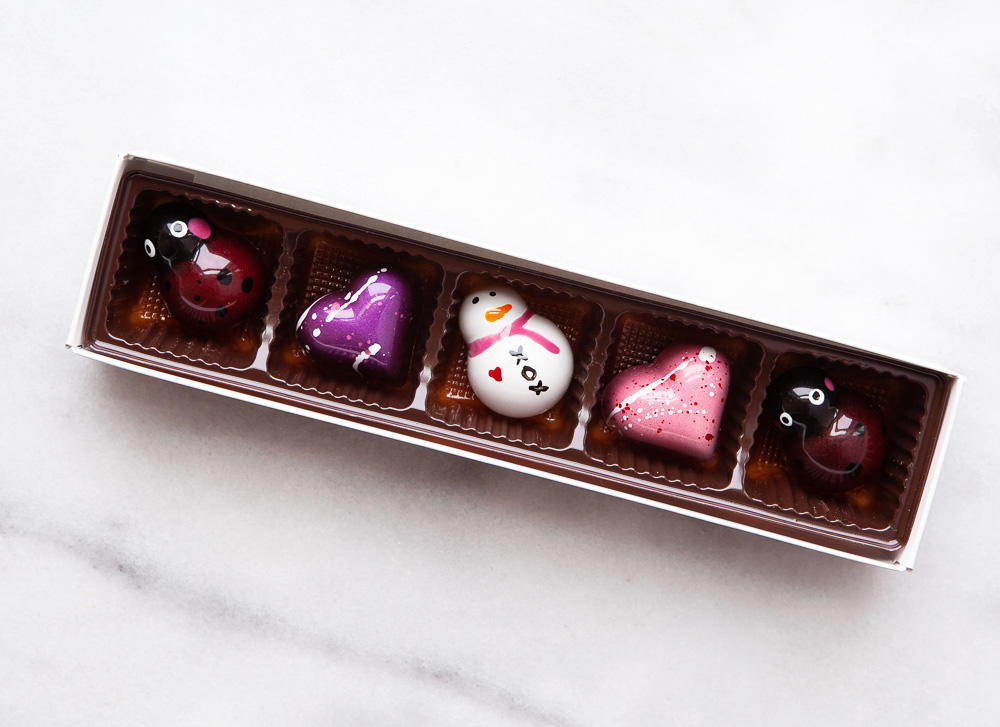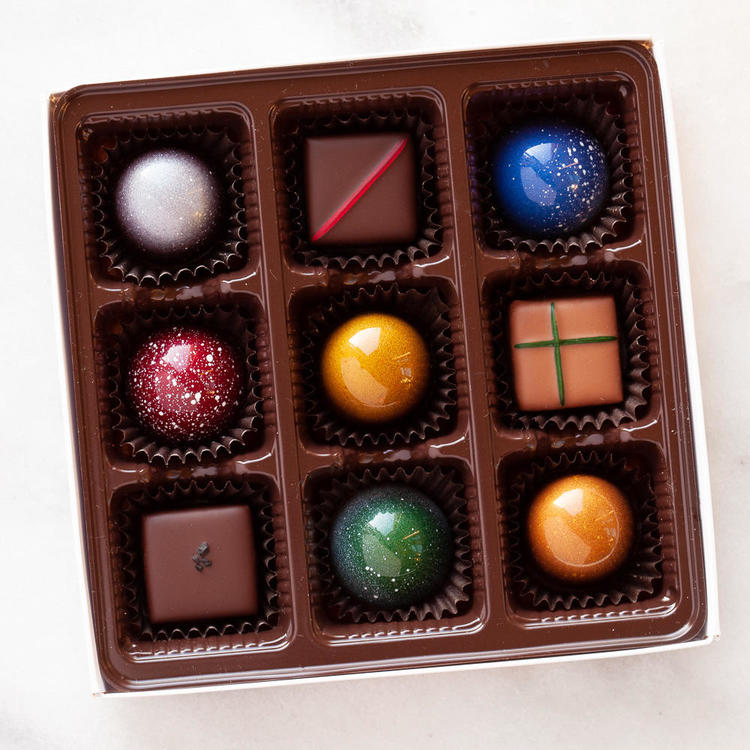
Pastrypastmidnight
participating member-
Posts
300 -
Joined
-
Last visited
Content Type
Profiles
Forums
Store
Help Articles
Everything posted by Pastrypastmidnight
-
It’s Greweling. “...fat added early in cooking is emulsified(...) Fat added late in cooking is not locked up in the emulsion (...) is also available to lubricate the cutters or knives (...)” page 236.
-
Ramon Morató says butter added between 114-119 will incorporate better and that butter added after 120C won’t “bind to the dough” because too much water has evaporated. Someone else, and I’m sorry I can’t find the reference, said butter added at the end makes caramel easier to cut—it will lubricate whatever you’re cutting with.
-
I second the salt suggestion—or cook your sugar darker.
-
I don’t think it makes a big enough difference to cause any issue. Honestly, it comes down to your target shelf life. Do you need something to last, like, 6 months—a year? Maybe then it would make a difference. I can’t really think of a ganache that wouldn’t spoil before your pdf would spoil. I’ve seen many professional recipes advocate blitzing the pdf to make it able to be piped. I’ve made pdf for piping many ways. Making a set pdf and blending with a mix of purée and glucose. Alternatively, you could make a sorbitol syrup. Cooking to a lower temperature. Cutting the pectin in half. They all work. They’ve all lasted at least 6 weeks. I’ve never had spoilage from any of these methods. Some bonbons I’ve had up to 3 months at cool room temp. The only time I’ve ever had spoilage was when I tried a recipe from here on eGullet where someone used pectin NH to make a pipable pdf. I tried it last year. I used that formula and my pdf layer fermented within a month. It was also really wet and weakened the shell. Thank goodness I didn’t give any of those away to anyone else.
-
Aspecialtybox and the labels are such a small batch that I’m literally printing at UPs and cutting with an exacto knife and straight edge. That needs to change ASAP. Just really good honey to give it some flavor. Other than that it’s pretty simple.
-
It’s been a while since I’ve shared anything. I’m just now pulling out of my post-Valentine’s Day coma and starting to work again. Here’s what kicked my butt the past month . My dessert-inspired Valentine’s collection (strawberries and cream, salted caramel hazelnut, lemon meringue, key lime cheesecake, Venezuelan dark, dark chocolate raspberry, passionfruit caramel, cherry cheesecake, crème brûlée): Cute little 5-piece (raspberry caramel, salted caramel, lemon meringue, peanut praliné): Bonbons are great and all, but this sponge toffee is what I can’t stop eating : And just a shot of the pretty packaging my friend designed for V-Day (now I need to decide on regular non-holiday branding): I love seeing what everyone is up to! Can’t wait to see what Easter brings. I’m soooooo ready for spring!
-
So, I’ve had Susanna’s bonbons and they are the best I’ve ever had. Both in terms of decor and taste/texture. But she is using the same basic techniques as other chocolatiers. Super clean molds, tempered cocoa butter for painting or spraying, thin chocolate shell, filling at just the right height, nice smooth caps. She is just meticulous about every single step. Her packaging in her boxes includes a clear tray with depressions for the domes to sit in and then a clear plastic cover to hold the bonbons in place. Maybe that’s what you’re seeing?
-
You can totally mix up a big batch of your own colored cocoa butter and then just melt and retemper when you need to use it.
-
So, I used to use acetate, but I think mine is too stiff and I would get cracks in my caps that I never get when I cap without the acetate. it’s also kind of messy. If I cap without acetate and work really quickly I can get almost no chocolate running down the sides of my mold, à la Susanna Yoon. https://www.instagram.com/p/BdXxdFYBV2_/?igshid=w37n31ueril1 I decided that plus the wastefulness of the acetate made it a less attractive option for me. It is super helpful if you have a very runny filling, you’re in a rush and your ganache is still too soft, or if you overfill, as was mentioned above.
-
Some help with Salted Caramels (caramels au beurre salé)
Pastrypastmidnight replied to a topic in Pastry & Baking
Good luck! -
Some help with Salted Caramels (caramels au beurre salé)
Pastrypastmidnight replied to a topic in Pastry & Baking
https://www.instagram.com/p/BJEouH1gitv/?igshid=1qrqqurydzrh4 Kriss mentions lecithin in the above Instagram post. All of Greweling’s chewy caramel recipes are Maillard caramels. As for percentages, I’m not sure. I use cream in my caramels, but Greweling, for some reason, has recipes with evaporated, fresh, and sweetened condensed milk. But no just fresh cream. But they seem similar-ish. -
Some help with Salted Caramels (caramels au beurre salé)
Pastrypastmidnight replied to a topic in Pastry & Baking
Kriss does a Maillard caramel (no sorbitol, yes lecithin). Instead of caramelizing the sugar and deglazing with cream, the sugars and cream cook together for a long time and the milk proteins cook and go through a Maillard reaction. With this method, the sugar never actually gets hot enough to caramelize. So it has more of a cooked dairy flavor than a burnt sugar flavor. I think @Chocolothas said she makes her cut/chewy caramels this way. Am I remembering that correctly? -
Chocolates with that Showroom Finish, 2012 –
Pastrypastmidnight replied to a topic in Pastry & Baking
Super scary, but thank you for the vote of confidence! Thank you! I am lucky to know a great graphic designer and I was so pleased with what she designed for me! -
Chocolates with that Showroom Finish, 2012 –
Pastrypastmidnight replied to a topic in Pastry & Baking
Well, the story has only just begun and I’m not 100% sure where it’s going yet, but yes :). After a few years of learning and practicing and randomly showing up pretty much anywhere and everywhere with bonbons to give away, my mom and I recently formed an LLC and launched our chocolate company Bliss Chocolatier. It’s a cottage food operation out of my home at the moment, but we’ve been working with a real estate agent to find a commercial space. I have to get out of my house for a million reasons. I’m sure I’ll update as we move forward. For now, I have an Instagram @bliss.chocolatier and a placeholder website with absolutely nothing on it yet ;). I’m trying to just take the next step and not worry too much about seeing the end from the beginning right now. Which is suuuuuper hard for my risk-averse personality. -
Chocolates with that Showroom Finish, 2012 –
Pastrypastmidnight replied to a topic in Pastry & Baking
Thanks so much, Jim! -
Chocolates with that Showroom Finish, 2012 –
Pastrypastmidnight replied to a topic in Pastry & Baking
I just thought I’d share my very first Christmas box because I was pretty pleased with how it turned out. The color scheme reminded me of The Nutcracker <3. Flavors are: hot chocolate, cranberry orange, milk and cookies, turtle, hazelnut crunch, speculoos butter praliné, salted caramel ganache, peppermint crunch, and spiced pumpkin caramel. -
Kind of this. I can’t tell you how many times I’ve shouted, “Chocolate is a STUPID hobby!” when I’ve been frustrated by trying to work in my home kitchen Around my family’s meal schedule or traipsing all over the house to retrieve the equipment I have squirreled away wherever there’s room or trying to keep chocolate in temper for more than a handful of molds with just a melter or when I just haven’t had the right tool for the job. The reality is, it’s just really frustrating. I agree with everyone above. First purchase: more molds. Pick something easy to use, paint, and polish. I have 20 half-sphere molds and 15 dome molds and use those for almost everything. Second: a melter makes a huge difference. Third: the EZTemper legitimately saves me so much time. Good luck!
-
Pâte de Fruits (Fruit Paste/Fruit Jellies) (Part 2)
Pastrypastmidnight replied to a topic in Pastry & Baking
I have his book but I didn’t see cranberry on my chart. I figured something out, though. -
Pâte de Fruits (Fruit Paste/Fruit Jellies) (Part 2)
Pastrypastmidnight replied to a topic in Pastry & Baking
Has anybody done a cranberry pdf? I can’t find cranberry on any of the, like, 4 different tables I have. Thanks! -
I think a better title for the production class would be “Recipes and Décor Techniques for Production.” I think the two classes are very similar but the production one only provides recipes with a 3 month shelf life and decor techniques that would be possible in a production setting. No suuuuuuuper tricky painting or super perishable fillings. The topics covered are really similar.
-
The glucose prevents the sugars in the chocolate from re-crystallizing and the invert sugar is there to keep it from drying out, and both sugars bind water, leading to a longer shelf life.
-
Wouldn’t jelly have less water than cream? So it reaches the final temp sooner because there is far less water to boil out?
-
More cream. By the time your sugar caramelizes there’s probably not much if any of that initial water left.
-
If your caramel is not fluid enough for you and you are not cooking it at all after adding the cream (i.e. caramelizing the sugar to desired color/temp, deglazing with cream/butter/etc. off the heat, and then using it), you don’t have enough liquid in your caramel. Putting it back on the heat will only make it stiffer as you will be cooking out more water. Are you starting out with a recipe for a chewy caramel candy or are you starting with a recipe designed to be a sauce or bonbon filling?
-
PLANNING: eGullet Chocolate and Confectionery Workshop 2020
Pastrypastmidnight replied to a topic in Pastry & Baking
Me me me!








